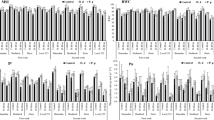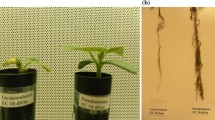Abstract
Plant growth-promoting bacteria (PGPB) represent a promising alternative to the massive use of industrial fertilizers in agriculture. Gluconacetobacter diazotrophicus is a PGPB that colonizes several plant species. Although this bacterium is able to grow at high sucrose concentrations, its response to environmental stresses is poorly understood. The present study evaluated G. diazotrophicus PAL5 response to stresses caused by sucrose, PEG 400, NaCl, KCl, Na2SO4 and K2SO4. Morphological, ultrastructural and cell growth analysis revealed that G. diazotrophicus PAL5 is more sensitive to salt than osmotic stress. Growth inhibition and strong morphological changes were caused by salinity, in consequence of Cl ion-specific toxic effect. Interestingly, low osmotic stress levels were beneficial for bacterial multiplication, which was able to tolerate high sucrose concentrations, Na2SO4 and K2SO4. Our data show that G. diazotrophicus PAL5 has differential response to osmotic and salinity stress, which may influence its use as inoculant in saline environments.




Similar content being viewed by others
References
Alexander B, Leach S, Ingledew WJ (1987) The relationship between chemiosmotic parameters and sensitivity to anions and organic acids in the acidophile Thiobacillus ferrooxidans. J Gen Microbiol 133:1171–1179
Baldani JI, Baldani VLD (2005) History on the biological nitrogen fixation research in graminaceous plants: special emphasis on the Brazilian experience. An Acad Bras Cienc 77:549–579
Boniolo FS, Rodrigues RC, Delatorre EO, da Silveira MM, Quintana Flores VM, Berbert-Molina MA (2009) Glycine betaine enhances growth of nitrogen-fixing bacteria Gluconacetobacter diazotrophicus PAL5 under saline stress conditions. Curr Microbiol 59:593–599. doi:10.1007/s00284-009-9479-7
Booth IR (1985) Regulation of cytoplasmic pH in bacteria. Microbiol Rev 49:359–378
Breedveld MW, Dijkema C, Zevenhuizen L, Zehnder AJB (1993) Response of intracellular carbohydrates to a NaCl shock in Rhizobium leguminosarum biovar trifolii TA-1 and Rhizobium meliloti SU-47. J Gen Microbiol 139:3157–3163
Brown AD (1964) Aspects of bacterial response to the ionic environment. Bacteriol Rev 28:296–329
Cavalcante V, Dobereiner J (1988) A new acid-tolerant nitrogen-fixing bacterium associated with sugarcane. Plant Soil 108:23–31. doi:10.1007/bf02370096
Chowdhury SP, Nagarajan T, Tripathi R, Mishra MN, Le Rudulier D, Tripathi AK (2007) Strain specific salt tolerance and osmoregulatory mechanisms in Azospirillum brasilense. FEMS Microbiol Lett 267:72–79
Cocking EC, Stone PJ, Davey MR (2006) Intracellular colonization of roots of Arabidopsis and crop plants by Gluconacetobacter diazotrophicus. In Vitro Cell Dev Biol Plant 42:74–82
Cruz CD (2006) Programa genes—biometria, vol 1. Editora UFV, Viçosa
DasSarma S, Arora P (2002) Halophiles. In: Encyclopedia of life sciences, vol 8. Nature Publishing Group, London, p 458–466
Deveci H, Jordan MA, Powell N, Alp I (2008) Effect of salinity and acidity on bioleaching activity of mesophilic and extremely thermophilic bacteria. Trans Nonferr Met Soc 18:714–721. doi:10.1016/s1003-6326(08)60123-5
Griffiths RI, Whiteley AS, O’Donnell AG, Bailey MJ (2003) Physiological and community responses of established grassland bacterial populations to water stress. Appl Environ Microbiol 69:6961–6968. doi:10.1128/aem.69.12.6961-6968.2003
IFA (2013) International fertilizer industry association. http://www.fertilizer.org/ifa/ifadata/search. Accessed 03 June 2014
Intorne A, Oliveira M, Lima M, da Silva J, Fb Olivares, Gar Souza Filho (2009) Identification and characterization of Gluconacetobacter diazotrophicus mutants defective in the solubilization of phosphorus and zinc. Arch Microbiol 191:477–483. doi:10.1007/s00203-009-0472-0
Koch S, Oberson G, Eugster-Meier E, Melle L, Lacroix C (2007) Osmotic stress induced by salt increases cell yield, autolytic activity, and survival of lyophilization of Lactobacillus delbrueckii subsp lactis. Int J Food Microbiol 117:36–42. doi:10.1016/j.ijfoodmicro.2007.01.016
Krulwich TA, Sachs G, Padan E (2011) Molecular aspects of bacterial pH sensing and homeostasis. Nat Rev Microbiol 9:330–343
Kucuk C, Kivanc M (2008) Preliminary characterization of Rhizobium strains isolated from chickpea nodules. Afr J Biotechnol 7:772–775. doi:10.5897/AJB08.026
Lourdes Velazquez-Hernandez M et al (2011) Gluconacetobacter diazotrophicus levansucrase is involved in tolerance to NaCl, sucrose and desiccation, and in biofilm formation. Arch Microbiol 193:137–149. doi:10.1007/s00203-010-0651-z
Luna MF, Galar ML, Aprea J, Molinari ML, Boiardi JL (2010) Colonization of sorghum and wheat by seed inoculation with G. diazotrophicus. Biotechnol Lett 32:1071–1076. doi:10.1007/s10529-010-0256-2
Luna MF, Aprea J, Crespo JM, Boiardi JL (2011) Colonization and yield promotion of tomato by G. diazotrophicus. Appl Soil Ecol. doi:10.1016/j.apsoil.2011.09.002
Madhaiyan A, Poonguzhali S, Hari K, Saravanan VS, Sa T (2006) Influence of pesticides on the growth rate and plant-growth promoting traits of G. diazotrophicus. Pestic Biochem Physiol 84:143–154. doi:10.1016/j.pestbp.2005.06.004
Miller KJ, Wood JM (1996) Osmoadaptation by rhizosphere bacteria. Annu Rev Microbiol 50:101–136. doi:10.1146/annurev.micro.50.1.101
Moradi A, Tahmourespour A, Hoodaji M, Khorsandi F (2011) Effect of salinity on free living—diazotroph and total bacterial populations of two saline soils. Afr J Microbiol Res 5:144–148
Muthukumarasamy R, Revathi G, Loganathan P (2002) Effect of inorganic N on the population, in vitro colonization and morphology of Acetobacter diazotrophicus (syn. G. diazotrophicus). Plant Soil 243:91–102. doi:10.1023/a:1019963928947
Oktyabrskii ON, Smirnova GV (2012) Redox potential changes in bacterial cultures under stress conditions. Microbiology 81:131–142. doi:10.1134/s0026261712020099
Pianetti A, Battistelli M, Citterio B, Parlani C, Falcieri E, Bruscolini F (2009) Morphological changes of Aeromonas hydrophila in response to osmotic stress. Micron 40:426–433
Reinhold-Hurek B, Hurek T (2011) Living inside plants: bacterial endophytes. Curr Opin Plant Biol 14:435–443
Rodrigues Neto J, Malavolta VA, Victor O (1986) Meio simples para o isolamento e cultivo de Xanthomonas campestris pv. citri tipo B. Summa Phytopathol 12:16
Saravanan et al (2007) Zinc metal solubilization by G. diazotrophicus and induction of pleomorphic cells. J Microbiol Biotechnol 17:1477–1482
Saravanan VS, Madhaiyan M, Osborne J, Thangaraju M, Sa TM (2008) Ecological occurrence of Gluconacetobacter diazotrophicus and nitrogen-fixing Acetobacteraceae members: their possible role in plant growth promotion. Microb Ecol 55:130–140. doi:10.1007/s00248-007-9258-6
Severin I, Confurius-Guns V, Stal L (2012) Effect of salinity on nitrogenase activity and composition of the active diazotrophic community in intertidal microbial mats. Arch Microbiol 194:483–491. doi:10.1007/s00203-011-0787-5
Shabala L, Bowman J, Brown J, Ross T, McMeekin T, Shabala S (2009) Ion transport and osmotic adjustment in Escherichia coli in response to ionic and non-ionic osmotica. Environ Microbiol 11:137–148. doi:10.1111/j.1462-2920.2008.01748.x
Shi B, Xia X (2003) Morphological changes of Pseudomonas pseudoalcaligenes in response to temperature selection. Curr Microbiol 46:120–123
Shiers DW, Blight KR, Ralph DE (2005) Sodium sulphate and sodium chloride effects on batch culture of iron oxidising bacteria. Hydrometallurgy 80:75–82
Sugawara M, Cytryn EJ, Sadowsky MJ (2010) Functional role of Bradyrhizobium japonicum trehalose biosynthesis and metabolism genes during physiological stress and nodulation. Appl Environ Microbiol 76:1071–1081. doi:10.1128/aem.02483-09
Tejera NA, Ortega E, González López J, Lluch C (2003) Effect of some abiotic factors on the biological activity of Gluconacetobacter diazotrophicus. J Appl Microbiol 95:528–535
van den Bogaart G, Hermans N, Krasnikov V, Poolman B (2007) Protein mobility and diffusive barriers in Escherichia coli: consequences of osmotic stress. Mol Microbiol 64:858–871. doi:10.1111/j.1365-2958.2007.05705.x
Von Blottnitz H, Rabl A, Boiadjiev D, Taylor T, Arnold S (2006) Damage costs of nitrogen fertilizer in Europe and their internalization. J Environ Plann Man 49:413–433. doi:10.1080/09640560600601587
Wainwright M, Canham LT, Al-Wajeeh K, Reeves CL (1999) Morphological changes (including filamentation) in Escherichia coli grown under starvation conditions on silicon wafers and other surfaces. Lett Appl Microbiol 29:224–227
Wood JM (2011) Bacterial osmoregulation: a paradigm for the study of cellular homeostasis. Annu Rev Microbiol 65:215–238. doi:10.1146/annurev-micro-090110-102815
Yang L, Jiang J, Wei W, Zhang B, Wang L, Yang S (2006) The pha2 gene cluster involved in Na+ resistance and adaption to alkaline pH in Sinorhizobium fredii RT19 encodes a monovalent cation/proton antiporter. FEMS Microbiol Lett 262:172–177. doi:10.1111/j.1574-6968.2006.00385.x
Yang W, W-q Qin, R-q Liu, Y-c Ren (2011) Effect of chloride ion on bacterial pre-oxidation of arsenic-containing gold concentrate. J Cent South Univ T 18:1418–1424. doi:10.1007/s11771-011-0856-6
Zammit CM, Mangold S, Rao Jonna V, Mutch LA, Watling HR, Dopson M, Watkin ELJ (2012) Bioleaching in brackish waters-effect of chloride ions on the acidophile population and proteomes of model species. Appl Microbiol Biotechnol 93:319–329
Acknowledgments
We want to thank the Conselho Nacional de Desenvolvimento Científico e Tecnológico (CNPq), Financiadora de Estudos e Projetos (FINEP), Coordenação de Aperfeiçoamento de Pessoal de Nível Superior (CAPES), Fundação Carlos Chagas Filho de Amparo à Pesquisa do Estado do Rio de Janeiro (FAPERJ) and Instituto Nacional de Ciência e Tecnologia da Fixação Biológica de Nitrogênio (INCT-FBN), which have supported this research. The first author received a CAPES fellowship.
Author information
Authors and Affiliations
Corresponding author
Ethics declarations
Competing interests
None declared.
Additional information
Communicated by Erko Stackebrandt.
Marcos Vinicius V. De Oliveira, Aline C. Intorne and Luciano de S. Vespoli have contributed equally to this work.
Rights and permissions
About this article
Cite this article
De Oliveira, M.V.V., Intorne, A.C., Vespoli, L.S. et al. Differential effects of salinity and osmotic stress on the plant growth-promoting bacterium Gluconacetobacter diazotrophicus PAL5. Arch Microbiol 198, 287–294 (2016). https://doi.org/10.1007/s00203-015-1176-2
Received:
Revised:
Accepted:
Published:
Issue Date:
DOI: https://doi.org/10.1007/s00203-015-1176-2




